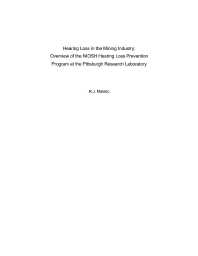Mining Publication: Hearing Loss in the Mining Industry: Overview of the NIOSH Hearing Loss Prevention Program at the Pittsburgh Research Laboratory
Original creation date: October 2005
Noise-induced hearing loss (NIHL) is the most common occupational illness in the United States. The use of heavy equipment, the drilling of rock, and the confined work environment are some of the factors that contribute to high levels of noise exposure to workers in the mining industry. Every day, 80% of the Nation's miners go to work in an environment where the time-weighted average (TWA) exceeds 85 dBA. Moreover, 25% of the miners are exposed to a TWA noise level that exceeds 90 dBA, the permissible exposure limit. Furthermore, a NIOSH analysis of a large sample of audiograms showed that at age 50 approximately 90% of coal miners and 49% of metal/nonmetal miners have a hearing impairment. By contrast, only 10% of the nonoccupational-noise-exposed population has a hearing impairment at age 50. Simply stated, most miners have a hearing loss by the time they retire. While NIHL is the most common occupational disease in this country, the problem is especially acute among workers in the mining industry. There are several barriers to reducing NIHL in the mining industry. These include gaps in knowledge of noise dose/source relationships, the unavailability of effective noise controls, and the need for worker education and worker empowerment. A related issue is the difficulty of communication in noisy workplaces by both hearing-impaired and normal hearing workers. The NIOSH Pittsburgh Research Laboratory (PRL) has strategically developed a hearing loss prevention program to overcome these barriers in an attempt to reduce NIHL in the mining industry. This paper provides an overview of the research program being conducted at PRL.
Authors: RJ Matetic
Conference Paper - October 2005
NIOSHTIC2 Number: 20028519
31st International Conference of Safety in Mines Research Institutes, 2-5 October 2005, Brisbane, Queensland, Australia. Redbank, Queensland, Australia: Safety in Mines Testing and Research Station (Simtars), 2005 Oct; :133-137
See Also
- Development and Evaluation of a Urethane Jacketed Tail Roller for Continuous Mining Machines
- Noise and Hearing Protection: Development of Two Training Exercises for Drillers
- Noise Exposure in Longwall Mining and Engineering Controls Research
- Noise Source Identification on a Continuous Mining Machine
- Noise Source Identification on a Horizontal Vibrating Screen
- Snapshot of Noise and Worker Exposures in Sand and Gravel Operations
- A Technique for Estimating the Sound Power Level Radiated by Pneumatic Rock Drills and the Evaluation of a CSIR Prototype Rock Drill with Engineering Noise Controls
- Water Well Safety Bits: Health And Safety Information For The Water Well Industry
- What Does a Hearing Loss Sound Like?
- Working in Noise with a Hearing Loss: Perceptions from Workers, Supervisors, and Hearing Conservation Program Managers
- Page last reviewed: 7/15/2015
- Page last updated: 7/15/2015
- Content source: National Institute for Occupational Safety and Health, Mining Program


 ShareCompartir
ShareCompartir
